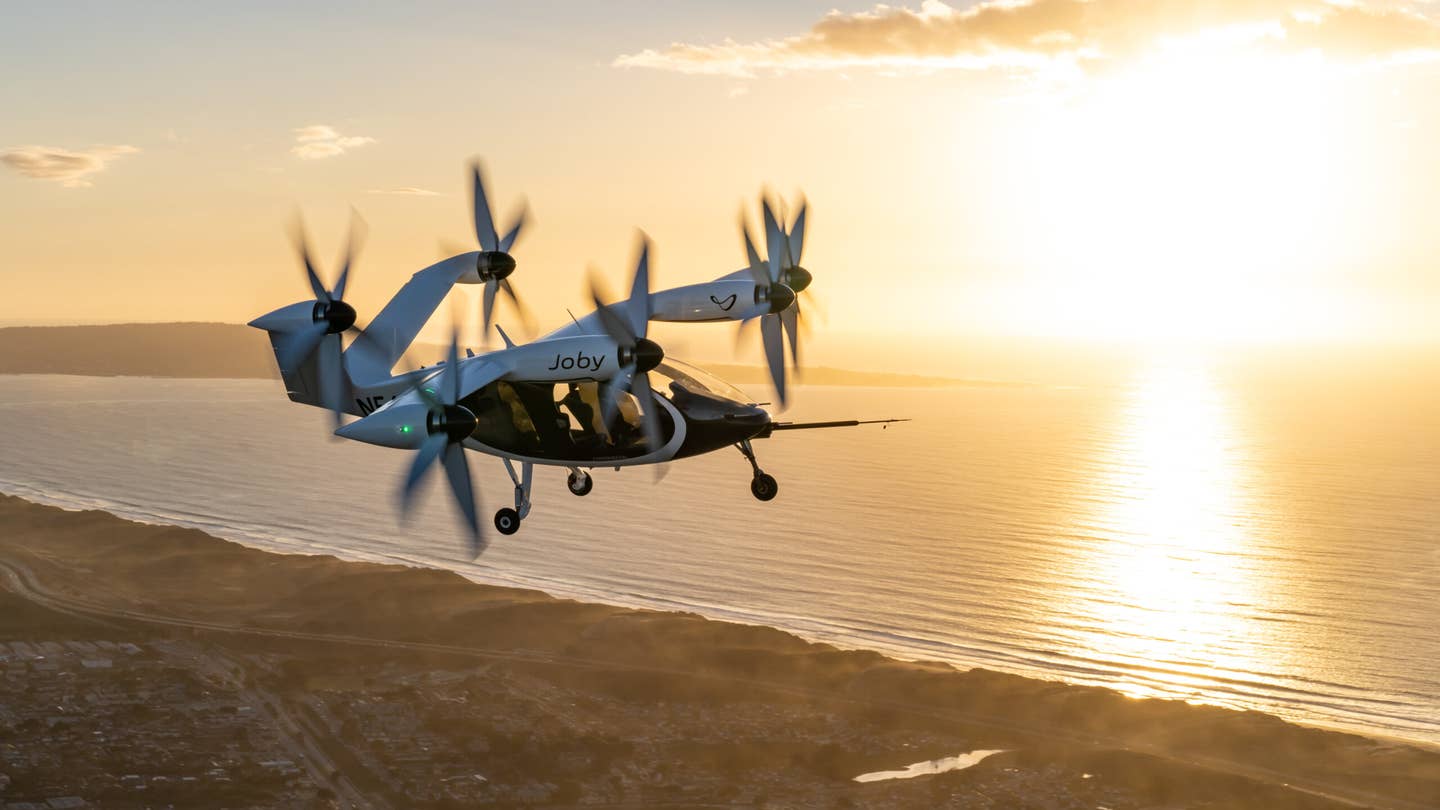Joby Acquires Autonomous Flight Developer Xwing
The electric vertical takeoff and landing (eVTOL) air taxi manufacturer in the future will look to integrate autonomy onto its flagship aircraft.

Joby’s eVTOL air taxi will initially be flown by an onboard pilot, but the manufacturer is exploring autonomous operations in the future. [Courtesy: Joby Aviation]
Joby Aviation is one of many electric vertical takeoff and landing (eVTOL) air taxi manufacturers that predicts autonomy will be the driver of ubiquity for advanced air mobility (AAM) services. And it’s putting its money where its mouth is.
Joby on Tuesday announced it acquired the autonomy division of Xwing, the developer of autonomous gate-to-gate flight software Superpilot, as it looks ahead to a transition to self-flying air taxi services. The manufacturer plans to initially operate the aircraft with onboard pilots and has a partnership with Delta Air Lines to launch commercial service as early as next year, beginning in New York and Los Angeles.
Terms of the deal were not disclosed. But the acquisition was paid for with Joby shares and covers “all of Xwing’s existing automation and autonomy technology activities,” the company said.
“The aircraft we are certifying will have a fully qualified pilot on board,” said JoeBen Bevirt, founder and CEO of Joby, “but we recognize that a future generation of autonomous aircraft will play an important part in unlocking our vision of making clean and affordable aerial mobility as accessible as possible.”
Like competitors Wisk Aero, the eVTOL subsidiary of Boeing, and Archer Aviation—which in August agreed to make Wisk the exclusive provider of autonomous systems for a future variant of its flagship air taxi—Joby evidently believes autonomy will be key to scaling up its operations.
The manufacturer began exploring pilotless flight in 2021 with the acquisition of radar developer Inras, whose technology it said it would use to develop an onboard sensing and navigation system.
One problem the eVTOL industry faces is a lack of powered-lift pilots, for which the FAA is working to develop a training and certification pathway. In the short term, autonomy could take on more flight functions, akin to autopilot technology on commercial airliners, to allow operations with smaller crews. Further out, it could allow Joby to remove the pilot from its aircraft entirely.
Wisk argues that the technology will further make operations safer and more affordable for passengers. That’s important, because eVTOL manufacturers, including Joby and Archer, claim their air taxi services will be cost-competitive with ground-based rideshare options such as Uber and Lyft.
Additionally, Joby said Xwing’s Superpilot will help it fulfill obligations for the U.S. Department of Defense, through which it is under contract with AFWERX, the innovation arm of the U.S. Air Force. The manufacturer has so far committed to four deliveries out of a total of nine air taxi orders—two each to Edwards Air Force Base in California and MacDill Air Force Base in Florida—delivering one to Edwards.
Joby in March estimated that the agreement has a total contract value of $163 million but on Tuesday said Xwing’s technology gives it room for growth.
“Autonomous systems are increasingly prolific in the private sector and bring potentially game-changing advantages to the Air Force as well,” said Colonel Elliott Leigh, director of AFWERX and chief commercialization officer for the Air Force. “We created Autonomy Prime to keep up with this shift and to stay engaged as a partner while this technology evolves so that we can adapt and evolve along with the private sector, maintaining our competitive advantage.”
Rather than develop autonomous software in-house, as it does for most of its aircraft’s components and systems, Joby will instead adopt the technology Xwing has been building since its founding in 2016.
A platform-agnostic system, Superpilot uses AI and machine learning algorithms to automate a range of tasks such as vision system processing, detect and avoid, decision making, and mission management, including route planning and live updates.
The system integrates into type-certified aircraft and is designed to change the role and location of the pilot, enabling remote supervision from a ground control station within the existing air traffic control system. However, Xwing on its website says the technology “is applicable to and will improve safety in both piloted and autonomous aircraft.”
Xwing began flying Superpilot-equipped aircraft in 2020 and has since completed more than 250 autonomous flights and 500 autolandings using a modified Cessna 208B Grand Caravan. Since 2021, it has operated a Part 135 air carrier business, flying 400 feeder cargo flights per week for UPS. Through a nonexclusive agreement with Cessna manufacturer Textron Aviation, the company intends to retrofit more small cargo aircraft, beginning with the Grand Caravan.
Last year, Superpilot became the first standard category large uncrewed aerial system (UAS) to receive an official FAA project designation, initiating the process for it to be approved for commercial cargo operations in U.S. national airspace. Under a three-year contract with NASA, Xwing is allowing researchers to study the technology and develop a safety management system (SMS) to integrate routine, pilotless flights alongside conventional aircraft.
In May 2023, the Air Force committed to exploring Superpilot for defense applications through a 21-month flight trial awarded by AFWERX. It must like what it’s seen so far, because less than a year into the partnership, it granted military airworthiness to Xwing’s modified Cessna, allowing it to begin performing cargo missions in unrestricted airspace. In February, the aircraft completed the Air Force’s first autonomous logistics mission.
Joby on Tuesday said Xwing engineers, researchers and technologists will join the manufacturer to seek out new technology development partnerships with the DOD. The department is eyeing autonomous cargo aircraft as a way to take human pilots out of potentially dangerous scenarios.
Like this story? We think you'll also like the Future of FLYING newsletter sent every Thursday afternoon. Sign up now.

Subscribe to Our Newsletter
Get the latest FLYING stories delivered directly to your inbox






